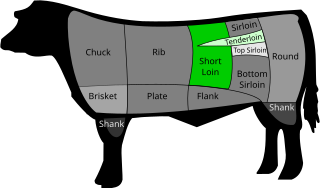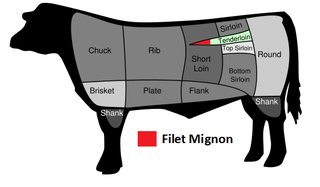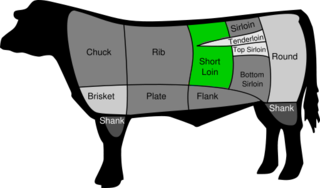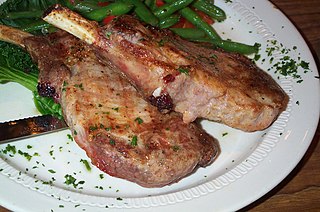
A beefsteak, often called just steak, is a flat cut of beef with parallel faces, usually cut perpendicular to the muscle fibers. In common restaurant service a single serving has a raw mass ranging from 120 to 600 grams. Beef steaks are usually grilled, pan-fried, or broiled. The more tender cuts from the loin and rib are cooked quickly, using dry heat, and served whole. Less tender cuts from the chuck or round are cooked with moist heat or are mechanically tenderized.

The T-bone and porterhouse are steaks of beef cut from the short loin. Both steaks include a T-shaped lumbar vertebra with sections of abdominal internal oblique muscle on each side. Porterhouse steaks are cut from the rear end of the short loin and thus include more tenderloin steak, along with a large strip steak. T-bone steaks are cut closer to the front, and contain a smaller section of tenderloin. The smaller portion of a T-bone, when sold alone, is known as a filet mignon, especially if cut from the small forward end of the tenderloin.

Chateaubriand is a dish that traditionally consists of a large front cut fillet of tenderloin grilled between two lesser pieces of meat that are discarded after cooking. While the term originally referred to the preparation of the dish, Auguste Escoffier named the specific front cut of the tenderloin the Chateaubriand.

A beef tenderloin, known as an eye fillet in Australasia, filet in France, filet mignon in Brazil, and fillet in the United Kingdom and South Africa, is cut from the loin of beef.

Filet mignon is a cut of meat taken from the smaller end of the tenderloin, or psoas major of a cow. In French, it mostly refers to cuts of pork tenderloin.

In American butchery, the sirloin steak is cut from the sirloin, the subprimal posterior to the short loin where the T-bone, porterhouse, and club steaks are cut. The sirloin is divided into several types of steak. The top sirloin is the most prized of these and is specifically marked for sale under that name. The bottom sirloin, which is less tender and much larger, is typically marked for sale simply as "sirloin steak". The bottom sirloin, in turn, connects to the sirloin tip roast.

The rib eye or ribeye is a boneless rib steak from the rib section.

Skirt steak is the US name for a cut of beef steak from the plate. It is long, flat, and prized for its flavor rather than tenderness. It is distinct from hanger steak (US), called skirt or onglet in Britain, a generally similar adjacent cut also from the plate.
Sir Loin, sirloin, or variant, may refer to:

Pork ribs are a cut of pork popular in Western and Asian cuisines. The ribcage of a domestic pig, meat and bones together, is cut into usable pieces, prepared by smoking, grilling, or baking – usually with a sauce, often barbecue – and then served.
The loins, or lumbus, are the sides between the lower ribs and pelvis, and the lower part of the back. The term is used to describe the anatomy of humans and quadrupeds, such as horses, pigs, or cattle. The anatomical reference also applies to particular cuts of meat, including tenderloin or sirloin steak.

During butchering, beef is first divided into primal cuts, pieces of meat initially separated from the carcass. These are basic sections from which steaks and other subdivisions are cut. Since the animal's legs and neck muscles do the most work, they are the toughest; the meat becomes more tender as distance from hoof and horn increases.

Short loin is the American name for a cut of beef that comes from the back of the cattle. It contains part of the spine and includes the top loin and the tenderloin. This cut yields types of steak including porterhouse, strip steak, and T-bone. The T-bone is a cut that contains less of the tenderloin than does the porterhouse. Webster's Dictionary defines it as "a portion of the hindquarter of beef immediately behind the ribs that is usually cut into steaks." The short loin is considered a tender beef.

Top sirloin is a cut of beef from the primal loin or subprimal sirloin. Top sirloin steaks differ from sirloin steaks in that the bone and the tenderloin and bottom round muscles have been removed; the remaining major muscles are the gluteus medius and biceps femoris.

A primal cut or cut of meat is a piece of meat initially separated from the carcass of an animal during butchering. Examples of primals include the round, loin, rib, and chuck for beef or the ham, loin, Boston butt, and picnic for pork.

A meat chop is a cut of meat cut perpendicular to the spine, and usually containing a rib or riblet part of a vertebra and served as an individual portion. The most common kinds of meat chops are pork and lamb. A thin boneless chop, or one with only the rib bone, may be called a cutlet, though the difference is not always clear. The term "chop" is not usually used for beef, but a T-bone steak is essentially a loin chop, a rib steak and a rib cutlet.

The cuts of pork are the different parts of the pig which are consumed as food by humans. The terminology and extent of each cut varies from country to country. There are between four and six primal cuts, which are the large parts in which the pig is first cut: the shoulder, loin, belly and leg. These are often sold wholesale, as are other parts of the pig with less meat, such as the head, feet and tail. Retail cuts are the specific cuts which are used to obtain different kinds of meat, such as tenderloin and ham. There are at least 25 Iberian pork cuts, including jamón.

A steak is a thick cut of meat generally sliced across the muscle fibers, sometimes including a bone. It is normally grilled or fried. Steak can be diced, cooked in sauce, such as in steak and kidney pie, or minced and formed into patties, such as hamburgers.

Baseball steak is a center cut of beef taken from the top sirloin cap steak. Baseball steaks differ from sirloin steaks in that the bone and the tenderloin and bottom round muscles have been removed; and the cut is taken from biceps femoris. A baseball steak is essentially a center cut top sirloin cap steak. This cut of beef is very lean, and is considered very flavorful.





















